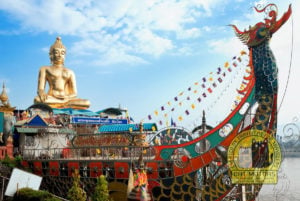Discover Wat Rong Khun: 22 Highlights of The White Temple
Wat Rong Khun, also known as the White Temple, is a spectacular and one-of-a-kind artistic creation that melds traditional Buddhist architecture with modern artistic expression. Situated in Pa O Don Chai, within the Mueang District of Chiang Rai Province, Thailand, it’s a brief journey from Chiang Mai. The vision of famed Thai artist Chalermchai Kositpipat, initiated in 1997, this privately held wonder features elaborate white sculptures and murals, emblematic of the purity and spiritual path in Buddhism. Globally, visitors are drawn to its awe-inspiring beauty and mesmerizing details, establishing it as an essential destination for anyone touring the area.
At the end of our online travel guide, you will find a detailed map of the temple grounds, with a legend describing all the buildings.
This guide primarily explores the architectural marvel in Chiang Rai, commonly known as the White Temple, but officially titled Wat Rong Khun. If you’re interested in the White Temple located in Chiang Mai, which is actually Wat Suan Dok, please refer to our specialized guide for that specific site.
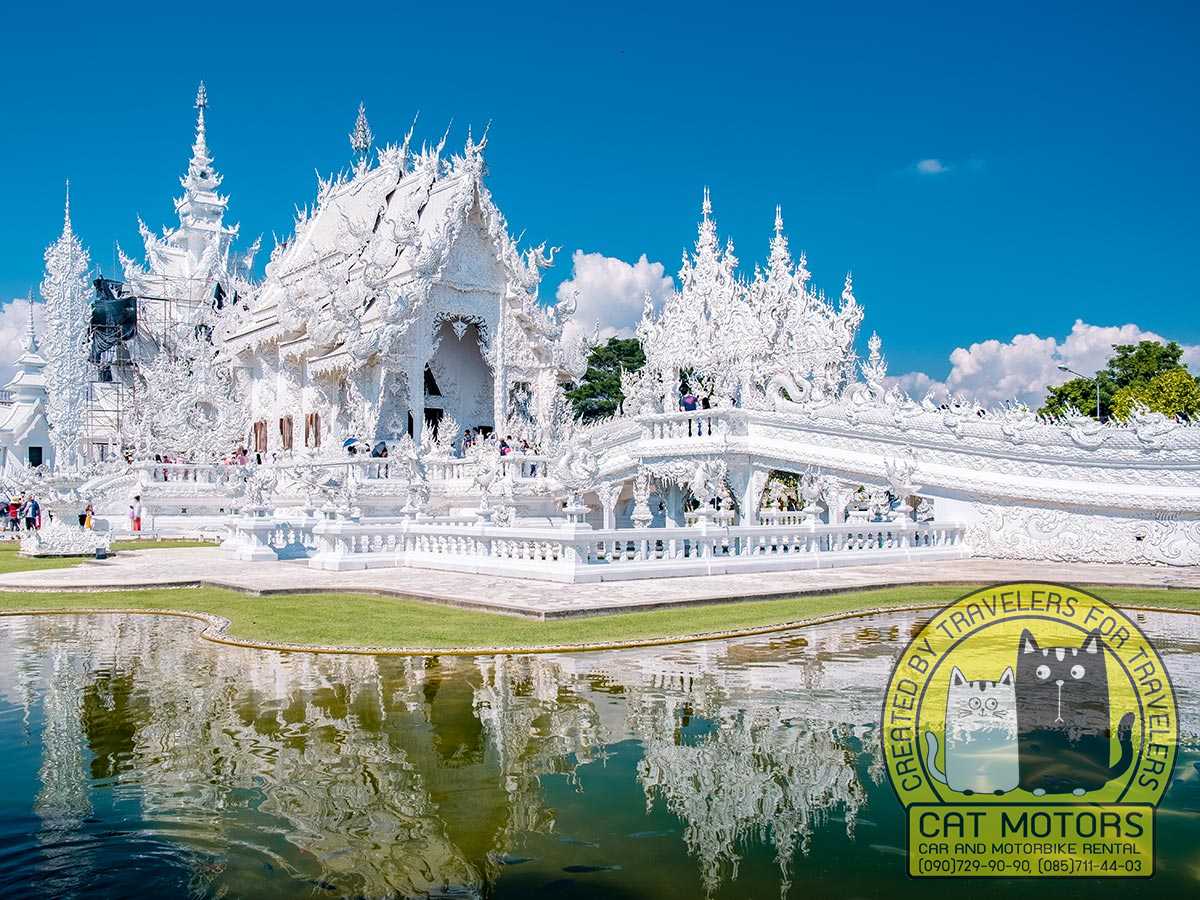
Nestled in the verdant surroundings, Wat Rong Khun in Chiang Rai emerges as an architectural wonder, drawing visitors with its celestial allure and unique, meaningful symbolism. Join us on a journey through the captivating realm of Chiang Rai’s White Temple to uncover its history and the profound meanings embedded in its design and art.
Located about 13 km (roughly a 20-minute drive) south of the city center of Chiang Rai, Northern Thailand (Google Map), this artistic masterpiece is set in immaculately kept gardens, with serene, tree-lined walkways. Its striking white exterior, an emblem of purity, presents a continuous interplay of light and shadow, embodying themes of virtue and vice.
Uncover The History Of Wat Rong Khun
National Artist Chalermchai Kositpipat, a native of Rongkhun village in Chiang Rai province, established himself internationally, earning scholarships in various countries. Between 1984 and 1988, he led a significant mural project at Wat Buddhapadipa in London.
By the end of the 20th century, the original structure in Chiang Rai was in a state of neglect and had been left due to insufficient restoration funds. Kositpipat acquired the property and embarked on a personal mission to rejuvenate it. His vision went beyond mere restoration; he aimed to create a new, thought-provoking edifice that also serves as a commentary on moral improvement.
Chalermchai Kositpipat’s ambition led to the birth of an extraordinary structure, transforming the old site into a modern marvel. He dedicated the White Temple in Chiang Rai as a tribute to Lord Buddha, aspiring for eternal life through this gesture. In 1997, Kositpipat unveiled the White Temple to the world.
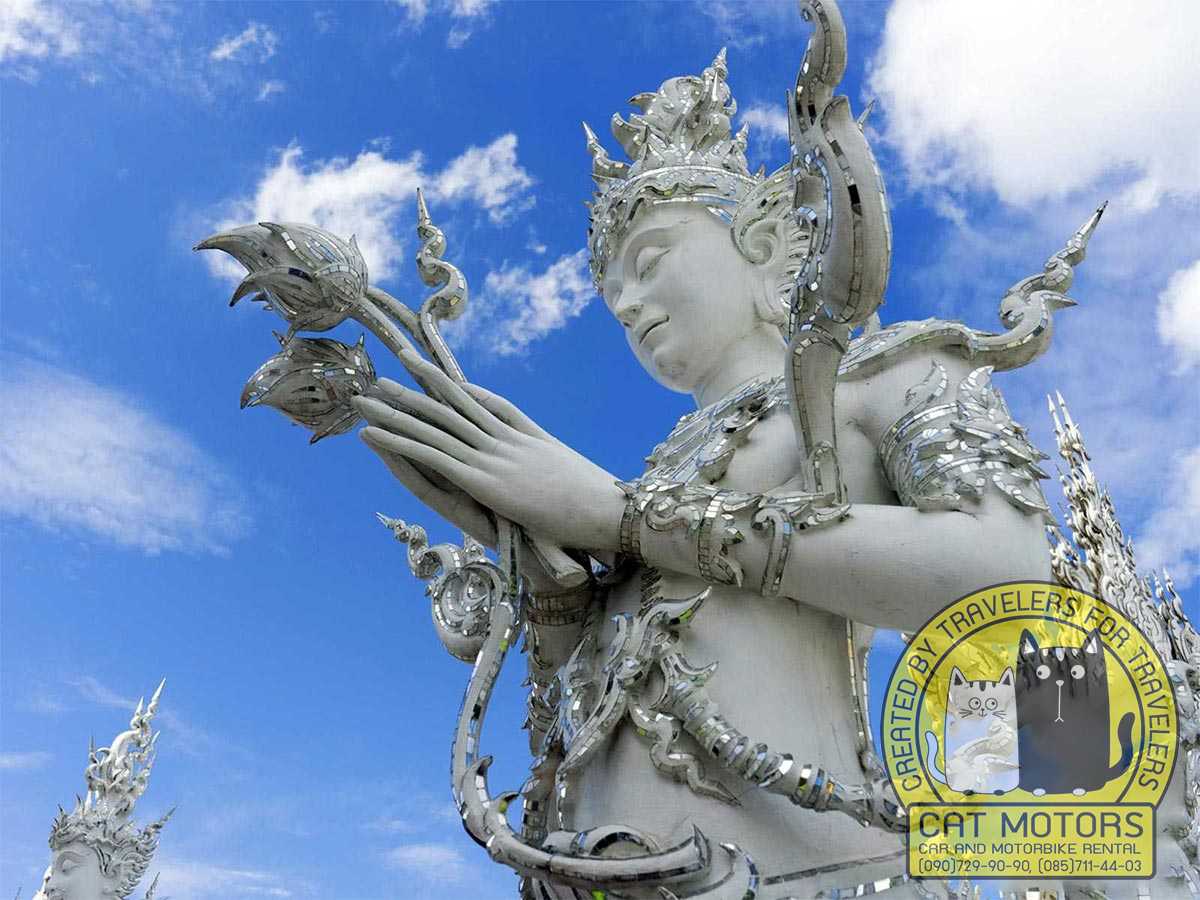
Additionally, Chalermchai revealed the truth about Wat Rong Khun:
“I intended to create a unique work of Buddhist art to be one of the greatest works of art this world has ever seen to announce the glory of my country to everyone throughout the planet. After I die, my students shall carry on my visions until they are all realized. All my affairs are in order in the event of my death. I created all these Buddhist works solely with my faith in Buddhism. I never wanted any compensation, and I never liked to make merit to show off. This temple never raises money through Kathin ceremonies. This temple was not constructed in a hurry to celebrate any occasion. My only intention is to make it as good and beautiful as possible… to the point that I exhausted both my worldly and dharma knowledge. Death would be the only thing that could stop my creative freedom.”
The comprehensive vision for this site involves the creation of nine structures, encompassing the existing ordination hall (ubosot). Future developments are set to include residential quarters for monks, a meditation hall, a hall for sacred relics, and spaces dedicated to art exhibitions. Kositpipat envisions the adjacent area to this architectural gem as a center for study and meditation, designed as a place where individuals can delve into and learn from Buddhist teachings.
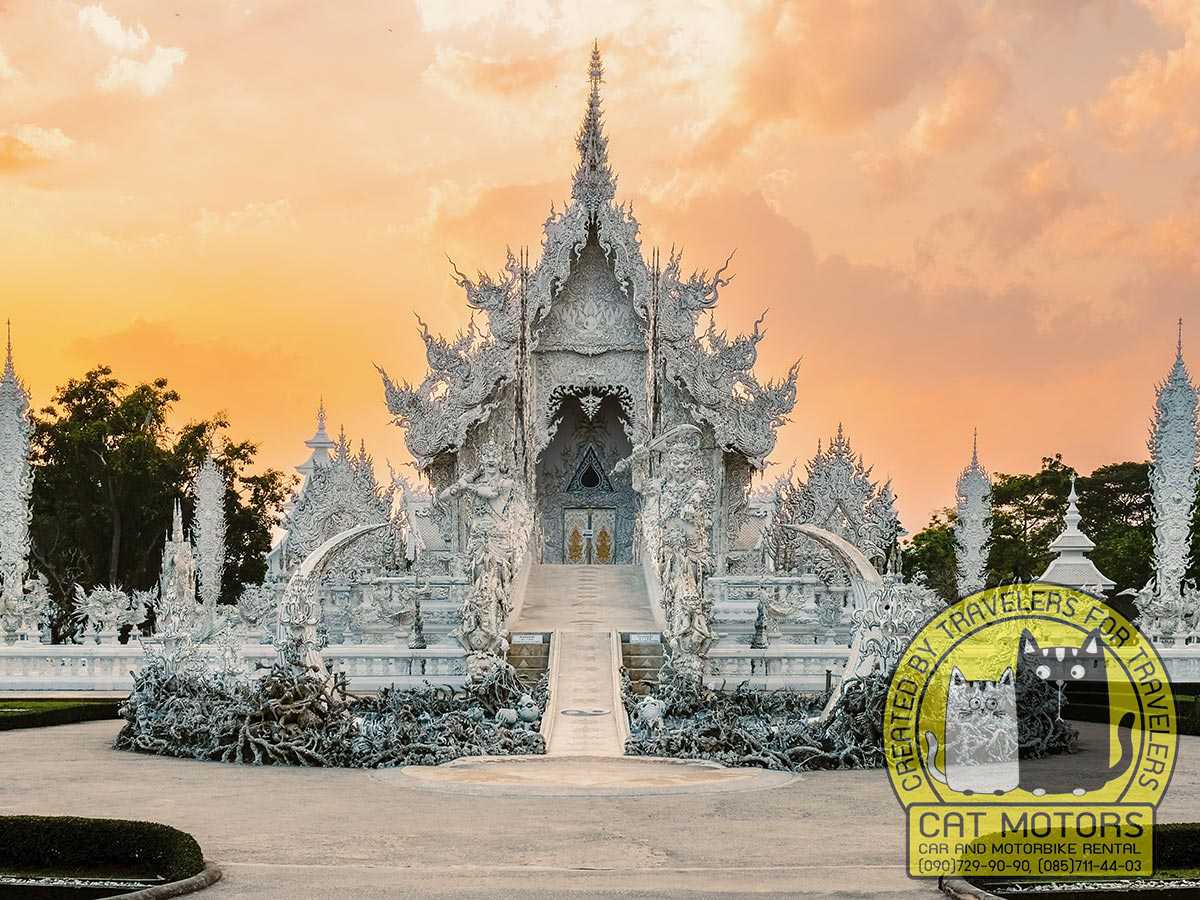
In May 2014, an earthquake damaged Wat Rong Khun, and Chalermchai intended to close the complex to prevent visitors from injury. However, an engineering team declared the buildings still structurally sound, so he decided to restore them to their former glory.
Ponder The Cultural And Spiritual Significance Of The White Temple
The White Temple in Chiang Rai stands out as a unique cultural landmark, merging contemporary artistry with traditional Buddhist elements. Its strikingly brilliant white exterior is a representation of purity, embodying the teachings of the Buddha.
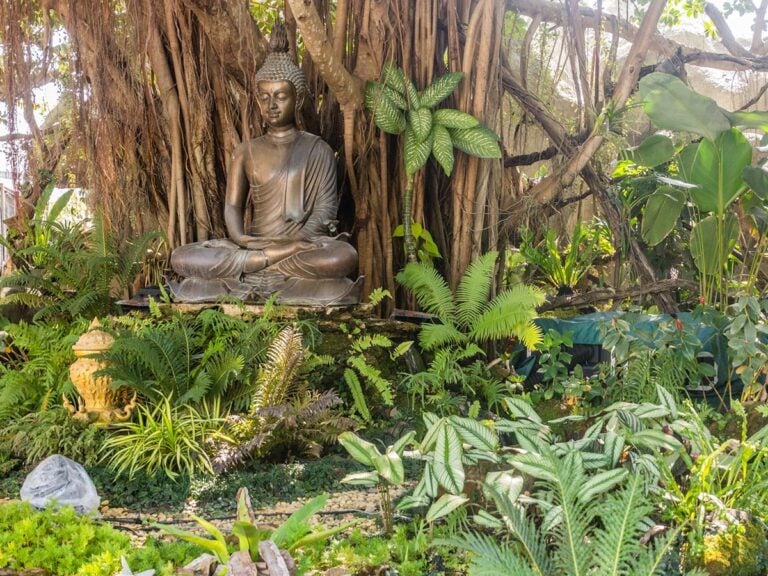
The façade of the Wat Rong Khun is embellished with detailed carvings and sculptures, showcasing a blend of traditional Thai artistry and contemporary styles. Each element in the complex, from the intricate murals to the exquisitely fashioned sculptures, narrates stories steeped in Thai culture and mythology.
Beyond its visual splendor, the White Temple holds profound spiritual importance for Buddhists and those on a spiritual quest. Its architectural design is deeply influenced by Buddhist philosophies, incorporating symbolic elements that represent Heaven, Hell, and the journey towards enlightenment.
Marvel At Wat Rong Khun's Breathtaking Designs
Upon first glance, Wat Rong Khun may appear as a beautiful amalgamation of diverse artistic concepts, but a deeper look reveals a consistent theme across the complex: the conquest of human vices such as greed, lust, and temptation. This central motif is depicted, sometimes graphically, in all the structures within the complex.
The Bridge Of The Cycle Of Rebirth
To reach the ubosot, the primary building in the White Temple, visitors traverse a bridge spanning a small lake. This journey confronts them with a striking visual: hundreds of reaching hands that represent the unbridled desires of humanity. This symbolic passage suggests that to ascend to a heavenly state, one must navigate and overcome earthly temptations and vices.
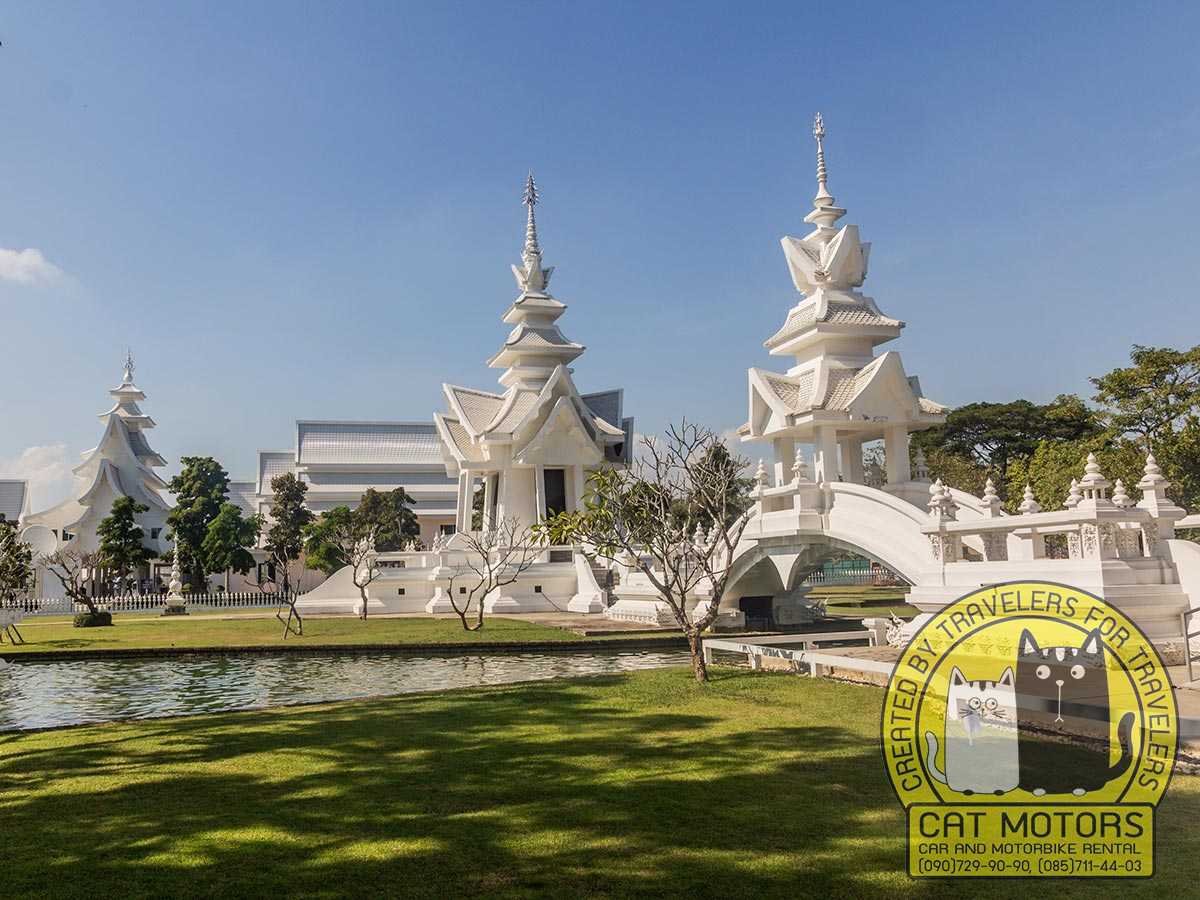
Flanking the lake stand two imposing Kinnaree, the Buddhist mythological creatures appearing half-human and half-bird.
The Gate Of Heaven
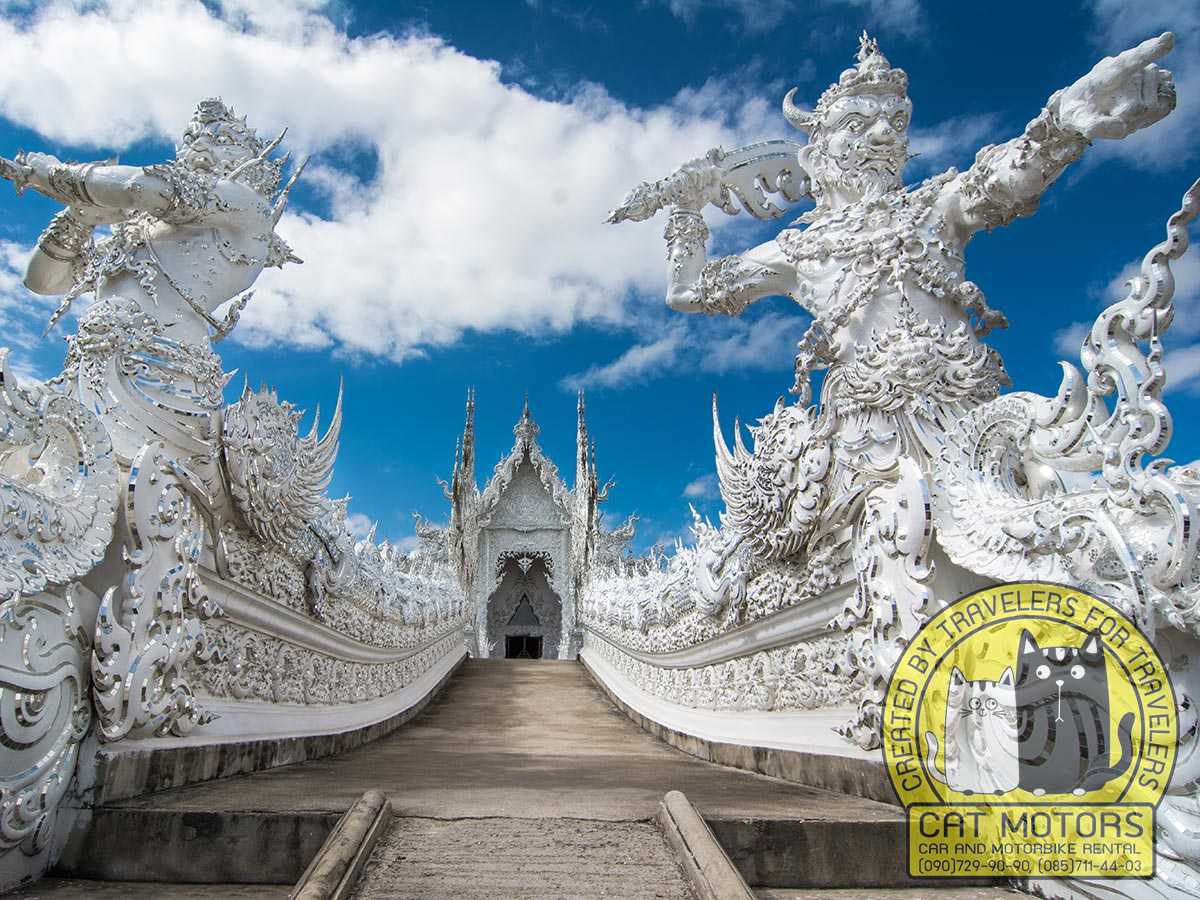
After crossing the bridge, visitors reach the Gate of Heaven, protected by two statues portraying Death and Rahu. These creatures judge the fate of the departed. There are also several Buddha images in meditative postures at the entrance to the ubosot.
The hands that reach out from beneath the ground symbolize the human yearning and suffering experienced within the cycle of rebirth, known as Samsara in Buddhist philosophy.
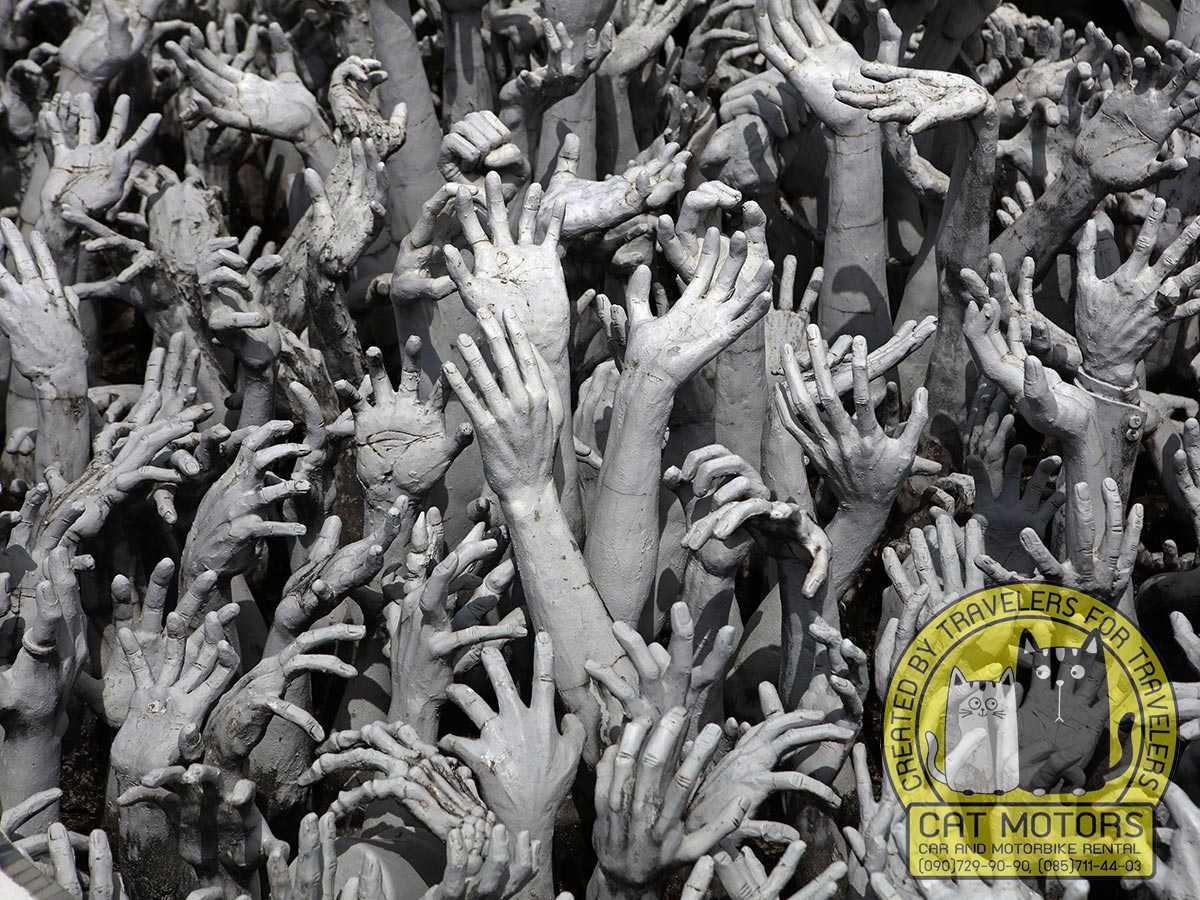
These hands reflect the souls that are immersed in this cycle, wrestling with desires and striving to reach a state of enlightenment. As a traveler and as a seeker of wisdom, confronting these symbolic hands becomes a personal journey, a passage through the struggles and temptations that confine one to an unenlightened state.
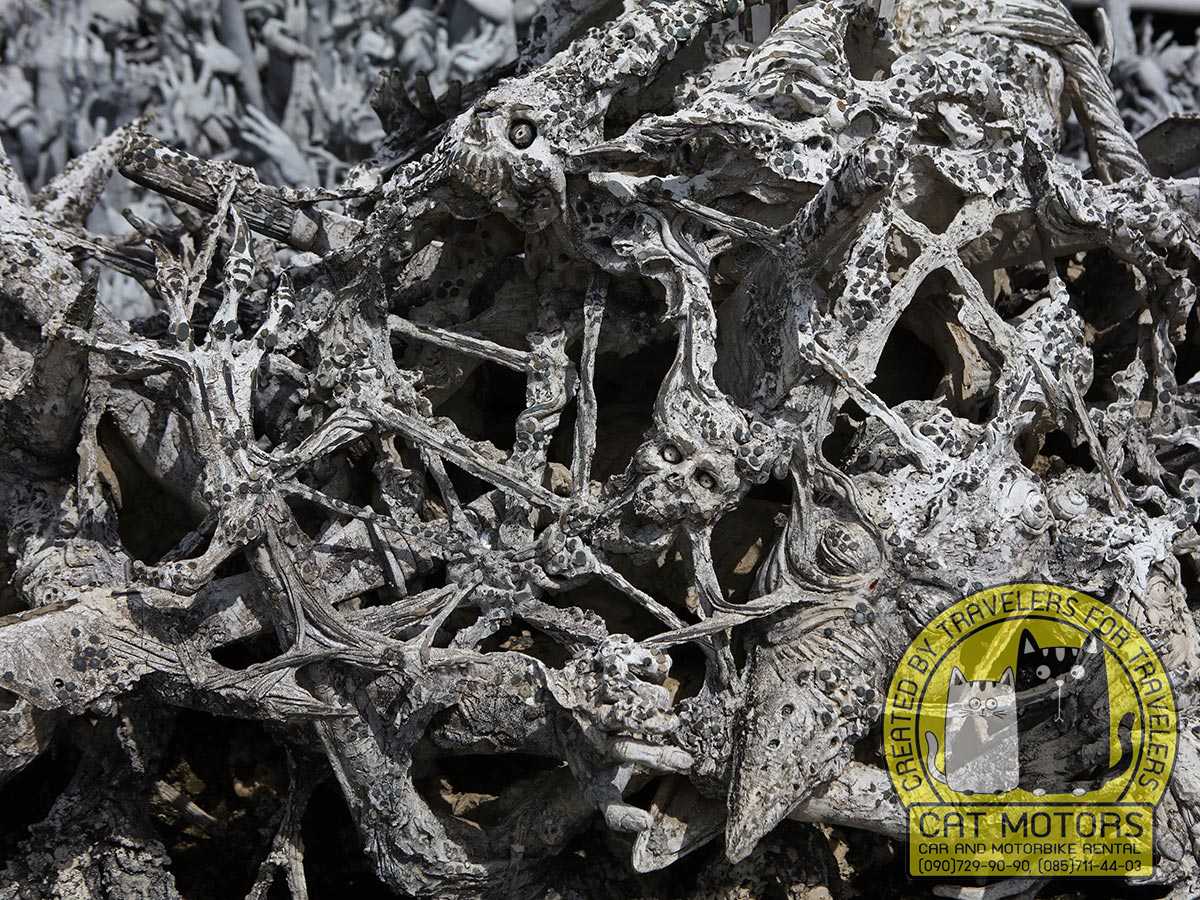
Visitors are guided towards a bridge, a metaphor for the path to enlightenment. Crossing this bridge signifies triumph over the trials represented by the reaching hands. This metaphorical journey embodies the fundamental teachings of Buddhism, highlighting the importance of transcending worldly attachments in favor of spiritual enlightenment.
The Ubosot
The brilliant white ubosot, which gives Wat Rong Khun its name, showcases the characteristics of the Lanna and Sukhothai architectural styles, typical of Northern Thailand, with features such as the three-tiered roof and the multitude of Naga serpents ornately placed around the structure.
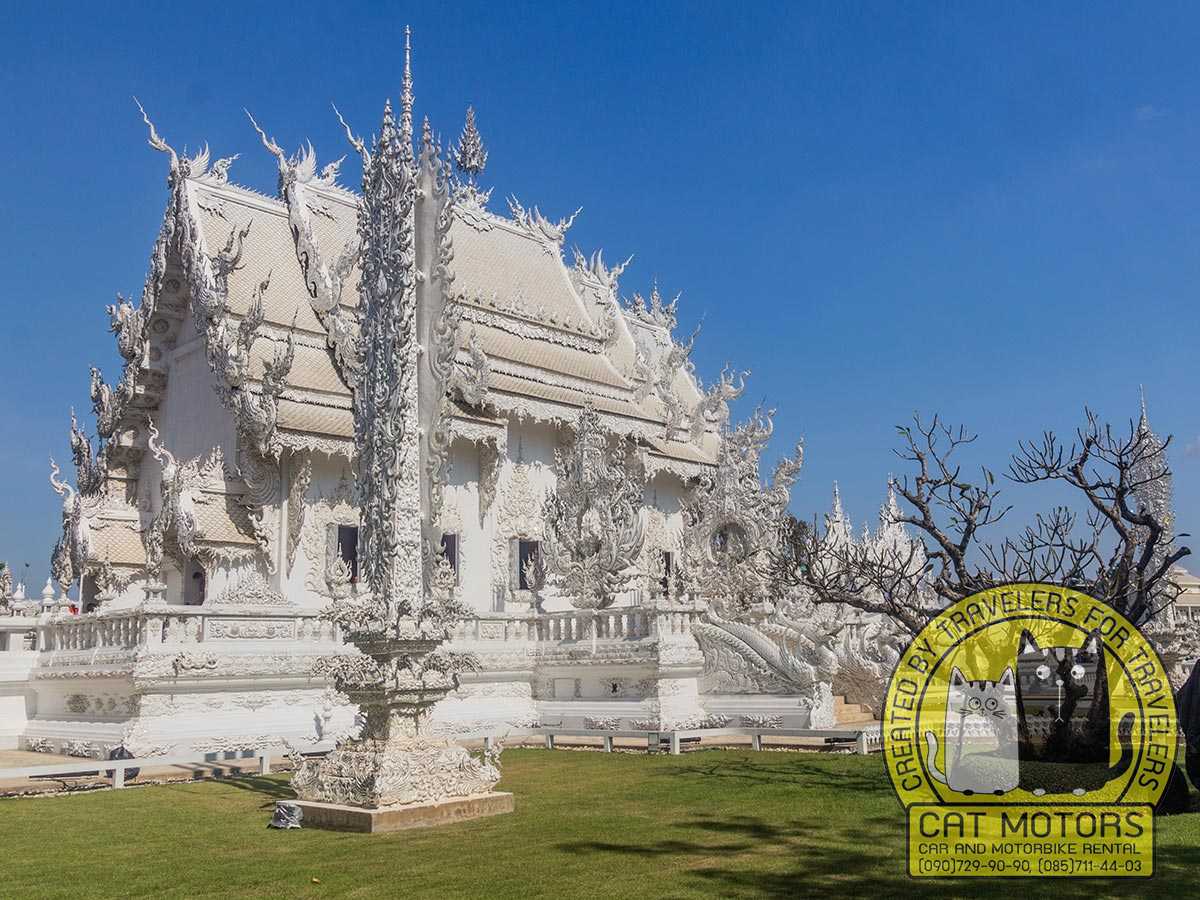
At first, the building appears to be constructed of sparkling porcelain. A closer inspection reveals that the ubosot is whitewashed and embedded with millions of tiny mirror mosaics. As the sun reflects off the mirrors, the temple glitters and gleams like a majestic fairy tale castle.
Wat Rong Khun’s white color symbolizes the Buddha’s purity, and the glass mosaics represent wisdom and enlightenment. The reflective surfaces beautifully capture the sunlight, evoking a sense of ethereal radiance.
Admire The Exquisite Art At White Temple
For the most part, the artist responsible for the bulk of the artworks is Chalermchai Kositpipat. His son and daughter are also talented artists, and some of their works are exhibited in the gallery.
Inside the ubosot, Wat Rong Khun’s décor does an about-turn from the brilliant white purity-themed exterior to a bewildering and almost evil interior. Visitors will encounter images of demons and blazing fires alongside Western celebrities such as Michael Jackson, characters from The Matrix, and Freddy Krueger.
Disturbing images of the attack on the World Trade Center, nuclear warfare, and oil pumps proclaim the human race’s destructive nature. While it’s evident that the artist is conveying the evil in human nature with these images, the message becomes a little foggy when mixed with pictures of Hello Kitty, Harry Potter, and Superman. The White Temple in Chiang Rai is indeed a gallery of contrasts.
Throughout the temple complex, visitors can find exquisite sculptures and sometimes very ghoulish statues crafted with meticulous attention to detail. These creations depict various mythological creatures, including Naga serpents and celestial beings from Thai Buddhist and Hindu mythology. Many shrines with Buddha images are also dotted around Wat Rong Khun.
Visitors will also find “wishing trees” and other structures where they can make a donation and hang their requests on the structure in the hope that their wishes will come true. A beautiful golden wishing well holds the same promise. This seems contradictory to the artist’s message, but the White Temple is nothing if not contrasting and contradictory!
Explore Chiang Rai's Dazzling White Temple
Reaching the temple in Chiang Rai is hassle-free, especially when joining a sightseeing tour. These tours offer a convenient way to explore various attractions in the region without the worry of navigation or getting lost. Another option for travelers is the use of Grab e-hailing service, metered taxis, local buses (which are the most economical choice), tuk-tuks, or songthaews.
Renting a scooter presents an affordable transportation alternative, but it’s crucial to have travel insurance and to rent only from reputable providers.
Despite Wat Rong Khun White Temple being more akin to an art exhibit than a traditional religious site, it is still regarded as a sacred place, necessitating modest attire for entry. Visitors should wear clothing that covers their knees, shoulders, and midriffs. For those unprepared, sarongs are readily available from vendors nearby. Shoes must be removed before entering the temple, and clothing with offensive or religious imagery should be avoided.
Photography and videography inside the White Temple are prohibited, but visitors can purchase image replicas at the souvenir shops.
Admission Fee: 100 baht for international guests, complimentary for Thai nationals
Operating Hours: 8 AM – 5 PM
Address: Pa O Don Chai, Mueang Chiang Rai District, Chiang Rai (Google Map)
Beyond Wat Rong Khun: Nearby Attractions
One can easily spend 1.5 – 2 hours exploring the temple, and the best times to go to avoid large crowds are probably in the early mornings or late afternoons before closing time. But that still leaves you the rest of the day to explore neighboring attractions. Read on to find our suggestions for nearby attractions and activities.
Singha Park
Singha Park is a massive park, formerly called Boon Rawd Farm, 2.7 km (1.7 miles) from Wat Rong Khun, Chiang Rai. The founding family that makes the well-known Singha beer turned the farm into a tourist attraction.
Visitors can enjoy tram tours around the farm or hire a bike to ride around it. There are many exciting activities that will keep the whole family entertained, including ziplining, a petting zoo, enjoying cosmos fields, and a swan lake. Entry to the park is free, but visitors pay for the different activities.
When you’ve spent your energy, you can refuel at the restaurants on-site, the bakery, coffee shops, and food trucks.
Operating hours: 8 AM – 6 PM (Monday to Friday), 8 AM – 7 PM (Weekends)
Address: 99, Moo 1, Mae Korn Subdistrict, Chiang Rai (Google Map)
Chiang Rai Clock Tower
Visitors impressed with Wat Rong Khun Temple’s artwork and design must visit the Golden Clock Tower in Chiang Rai. This splendid landmark is another of National Artist Chalermchai Kositpipat’s creations. It looks particularly beautiful at night, and visitors can enjoy light shows on the hour from 7 PM to 9 PM.
The Chiang Rai Clock Tower sits in the middle of a roundabout in Chiang Rai city center, approximately 13 km (8 miles) north of Chiang Rai White Temple.
Address: Suk Sathit, Tambon Wiang, Chiang Rai (Google Map)
Baan Dam Museum
The Black House, or Baan Dam Museum, is almost a complete contrast to Wat Rong Khun. This art museum, designed and built by Thawan Duchanee, is 27.6 km (16.5 miles) from the temple. The compound consists of 40 buildings, mostly black or very dark in color, signifying the darker side of humankind.
Duchanee used all kinds of animal remains and taxidermy in his artworks, including buffalo horns, crocodile skins, and snake skins. While a fascinating art museum that challenges one’s thoughts and conscience, Baan Dam Museum may not be animal lovers’ favorite place due to all the animal remains.
Admission fee: 80 baht
Operating hours: 9 AM – 5 PM daily, (closed 12 PM – 1 PM for lunch time)
Address: 333 Moo 13, Nang Lae, Chiang Rai (Google Map)
Chiang Rai Night Bazaar
Tourists love Thai markets, and the Chiang Rai Night Bazaar does not disappoint. The Night Bazaar is 13.6 km (8.5 miles) from Wat Rong Khun. It boasts many food stalls where one can eat a good meal at very reasonable prices. Visitors can also enjoy live music while browsing stalls selling clothing, souvenirs, and handicrafts.
Operating hours: 6 PM – 11 PM daily
Address: WR4M+5M2, Tambon Wiang, Mueang Chiang Rai District, Chiang Rai (Google Map)
Blue Temple
The Blue Temple in Chiang Rai, distinguished by its striking blue hue, embodies the essence of the Dharma—the teachings of Buddha—reaching skyward, spreading serenity and wisdom universally. Its vivid blue and gold design marks a refreshing divergence from the more common white and gold temples, representing the limitless nature of Dharma. This reminds us that paths to enlightenment are varied and not confined to traditional forms.
Wat Rong Suea Ten (Google Map), a contemporary addition to the region’s spiritual landscape, was completed in 2016. Its name, meaning ‘House of the Dancing Tiger’, references a time when tigers were frequently seen leaping across the nearby river. Entering the temple, visitors are welcomed by a striking white Buddha statue in meditation, dressed in regal attire, symbolizing purity, wisdom, and the enlightenment journey. The meticulous detailing of this statue accentuates the nuanced path to spiritual awakening.
Interesting Facts
There is a majestic gold-colored building on the temple grounds. Many tourist guides call it the Golden Temple, an independent architectural structure symbolizing immortality, wealth, and nirvana.
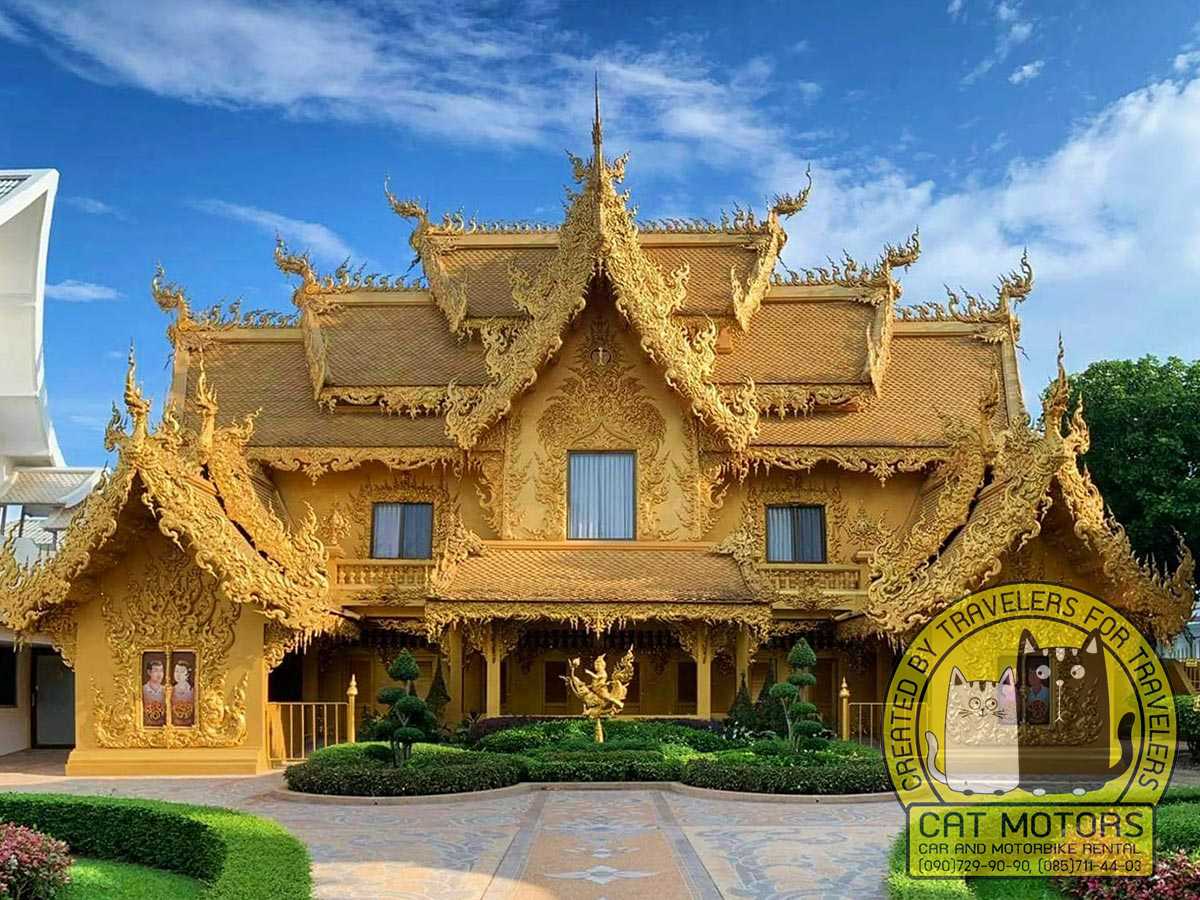
In fact, this building is a public restroom. Yes, it is beautiful and impressive, as if it were some king’s palace. But… it’s just a toilet.
Visitor map
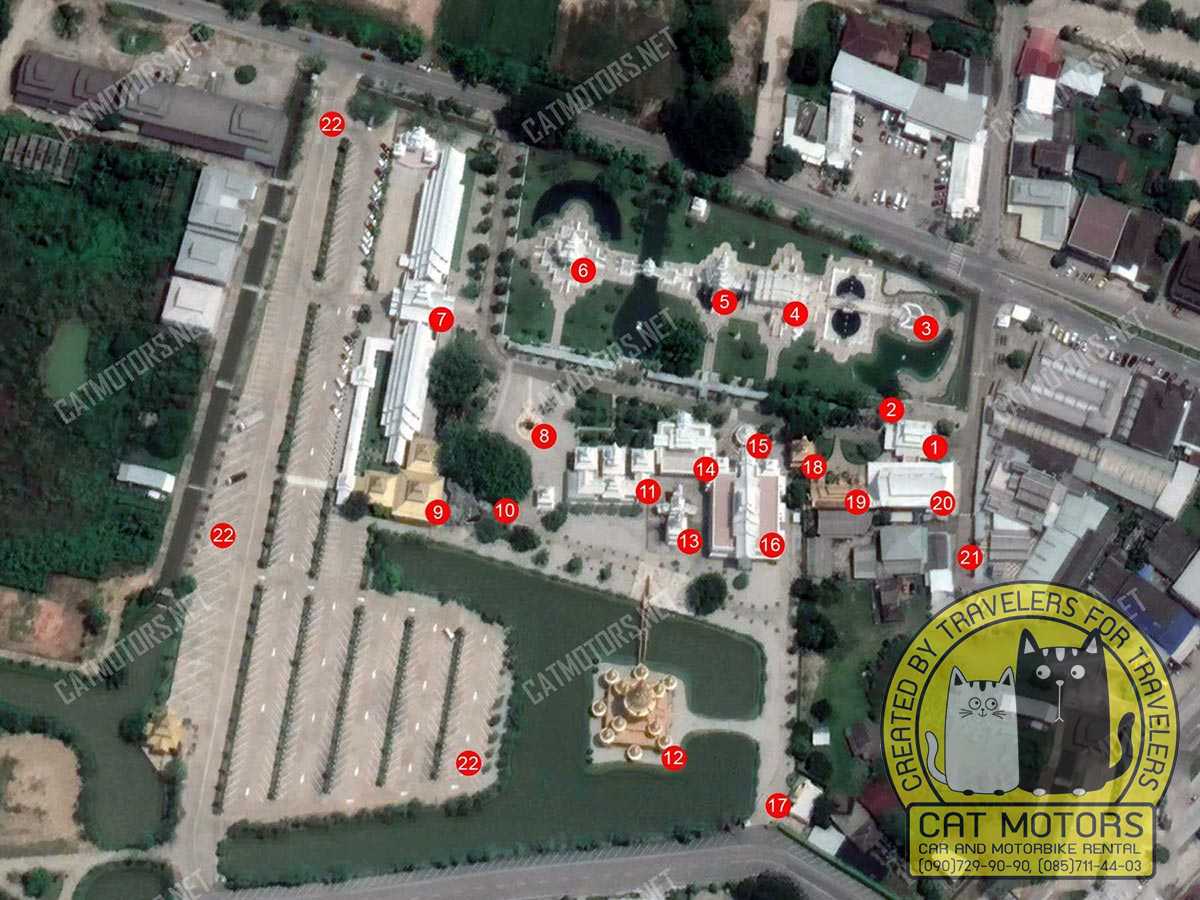
As of our last update, the entrance fee for foreign visitors to the temple was 100 Thai Baht. However, entrance fees can change over time, so we recommend checking the most current information before your visit.
Map Legend
The points of interest on the map are described in the order in which you will walk around the temple grounds. The only exception is parking lot #22, where you will park your motorcycle or car before walking around the temple.
1 – Main Entrance
2 – Purify Tower
3 – Mouth of Death
4 – Main Building
5 – Buddha Relics Tower
6 – Buddhist Tower
7 – Souvenir Shop
8 – Belfry
9 – Waterfall
10 – Golden Toilet #1
11 – Parsonage
12 – Ganesha Exhibition Hall
13 – Cemetry
14 – Ceremony Hall
15 – Wishing Well
16 – Dhamma Hall
17 – Golden Toilet #2
18 – PR Office
19 – Golden Toilet #3
20 – Souvenir Shop
21 – Art Galery
22 – Parking
Quick Facts
1. Distinctive White Temple: Wat Rong Khun, also celebrated as the White Temple, stands as a visually arresting Buddhist site in Chiang Rai, Thailand. Its all-white façade represents purity and the enlightenment journey.
2. Contemporary Origin: Contrasting with many of Thailand’s historic sites, Wat Rong Khun is a modern creation, envisioned and commenced by the acclaimed Thai artist Chalermchai Kositpipat in 1997.
3. Meaningful Design: The temple’s architecture is rich in detail and symbolism. The white hue signifies Buddha’s purity, while the mirror fragments embedded in the structure reflect wisdom and Buddhist teachings.
4. Artistic Innovation: The temple distinguishes itself with its unconventional and contemporary artistic aspects, blending traditional Buddhist themes with modern cultural references. Its murals cover a range of subjects from popular culture to historical events.
5. The Path to Enlightenment: The bridge to the main temple, known as the “Cycle of Rebirth,” symbolizes the passage from life and death towards enlightenment.
6. Development and Support: Still under construction, the temple’s growth and enhancements are supported entirely by private donations, with plans for ongoing evolution.
7. Exploring the Complex: The site includes various structures, sculptures, and gardens, allowing visitors to discover the assembly hall, meditation space, and art gallery. It’s a unique intersection of spiritual and contemporary artistic experiences.
8. Conservation Efforts: The temple’s unique design and delicate construction necessitate regular upkeep and restoration, leading to occasional closures for these purposes.
9. Respectful Visitation: Proper attire is essential, covering shoulders and knees. While photography is permitted in the outer areas, it is restricted within the main hall, along with mobile phone usage.
10. A Celebrated Destination: Wat Rong Khun has evolved into a significant tourist draw in Chiang Rai, attracting global visitors who are captivated by its architectural and artistic marvels.
Our Summary
Wat Rong Khun in Chiang Rai is more than simply an architectural wonder. As visitors immerse themselves in the profound symbolism and mesmerizing beauty of the White Temple, they embark on a spiritual journey, discovering the essence of Thai Buddhism. A visit to this extraordinary temple is an experience that lingers in the minds of all who witness its ethereal splendor.
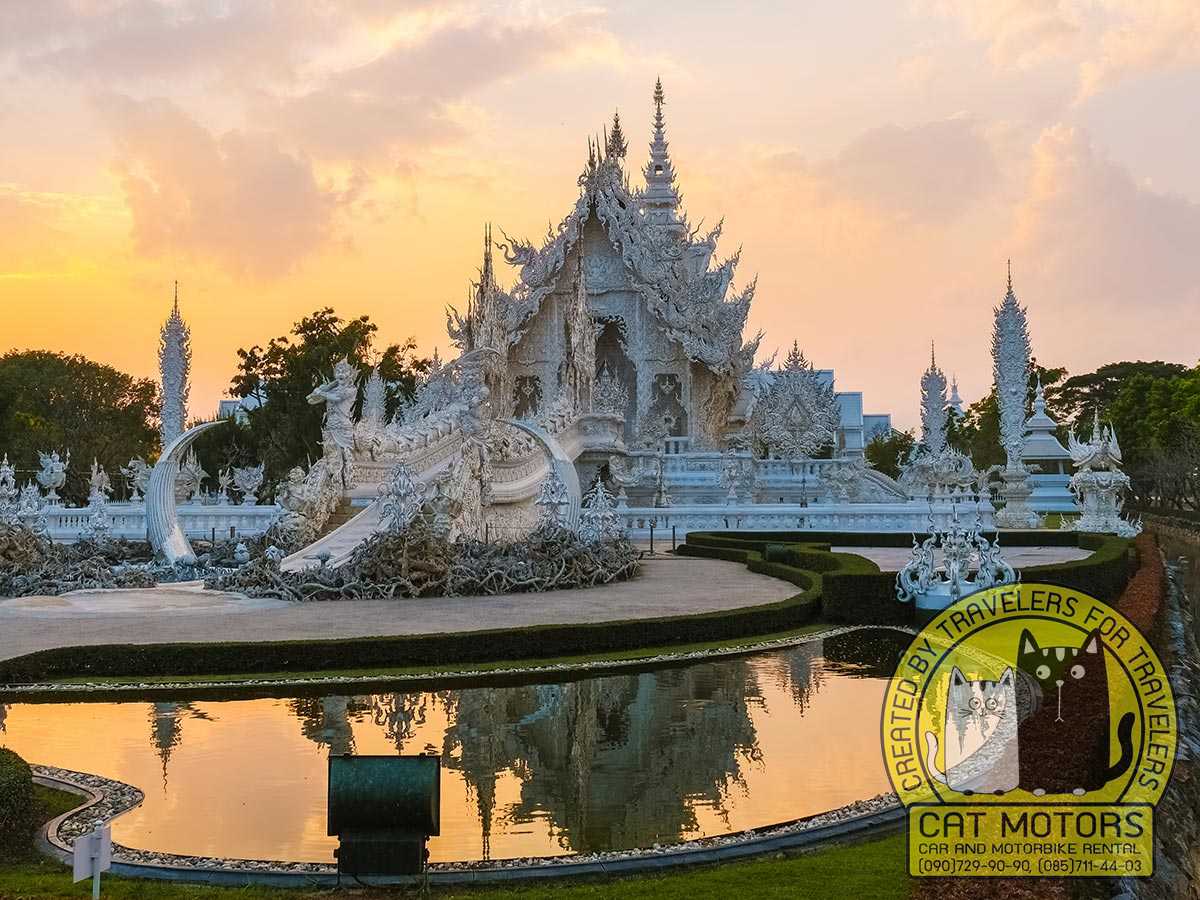
Weather Forecast
FAQ
As a renowned Thai visual artist, Chalermchai Kositpipat is the creative mind behind Wat Rong Khun. His inspiration came from the desire to offer an immersive representation of Buddhist teachings while encapsulating Thai cultural elements.
The White Temple’s color signifies the purity of the Buddha. The white exterior, embellished with fragments of mirrored glass, symbolizes Buddha’s wisdom shining universally.
The bridge at Wat Rong Khun is a depiction of the path towards rebirth in Buddhism. It is a transition from the cycle of death and rebirth (samsara) towards attaining enlightenment and entering Nirvana.
Every detail in Wat Rong Khun’s architecture carries Buddhist symbolism. For instance, the sea of hands reaching out from below the bridge represents desire, which one must overcome to attain enlightenment.
The gable apexes signify various precepts in Buddhism. The first tier represents the basic precepts, the second tier signifies concentration, and the third tier embodies wisdom. These are key principles one must master to break free from the cycle of samsara.
The murals inside the temple intricately blend traditional Buddhist imagery with contemporary symbols, intending to make Buddhist teachings relevant to the modern world.
Desire, in Wat Rong Khun, is depicted through numerous outstretched hands under the bridge, signifying human suffering and craving. One must rise above these to reach the state of enlightenment.
The principles of meditation are embodied in the design of the temple’s roof, where each tier represents a different aspect: precepts, concentration, and wisdom. These elements reflect the path to enlightenment in Buddhism.
The White Temple is a lifelong project for its creator, Chalermchai Kositpipat. He envisions it to be a center for learning and meditation. The ongoing construction symbolizes the evolution and continuation of Buddhist teachings.
The interior artworks reflect meditation practices by illustrating the journey from suffering and desire (depicted on the floor) to enlightenment (depicted on the ceiling). The path between these two states embodies the practice of meditation.
Unlike most traditional Buddhist temples, Wat Rong Khun is distinctly white, symbolizing the Buddha’s purity. Its architecture intricately weaves contemporary elements with traditional Buddhist symbolism, providing a unique interpretation of Buddhist teachings.
Wat Rong Khun has become a major tourist attraction in Chiang Rai and has significantly contributed to local tourism. Furthermore, it offers a unique interpretation of Buddhist principles to a global audience, promoting a deeper understanding of Buddhism’s essence.
Discover the hidden gems of Northern Thailand with our detailed travel guides, featuring the best scenic routes and local highlights. Start your journey by exploring our motorbike rental in Chiang Mai. Don’t forget to review our terms and conditions to ensure a smooth rental process. With these resources, you can confidently navigate mountain trails and charming villages.
Our travel advice sections provide a wealth of information on how to stay safe and make the most of your journey. Learn about the best times to visit key attractions, enjoy local festivals, and manage various road conditions. These insights will enhance your travel experience, making it both safe and enjoyable. Let us guide you through the stunning landscapes and vibrant culture of Northern Thailand, ensuring your trip is unforgettable.
- Author: Natcha Lindberg
- Updated: 26/03/2025
- No Comments



